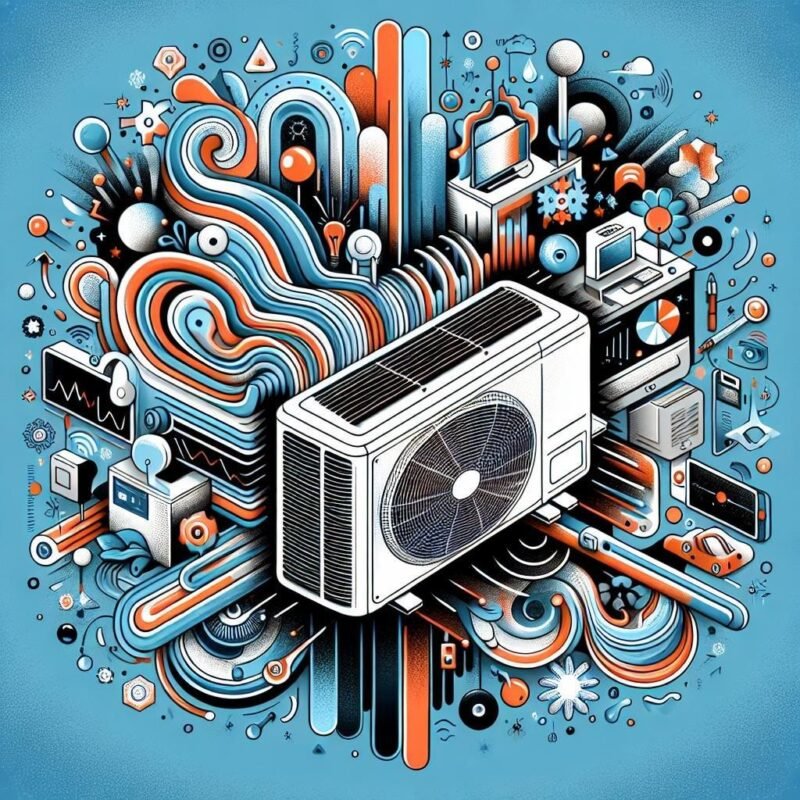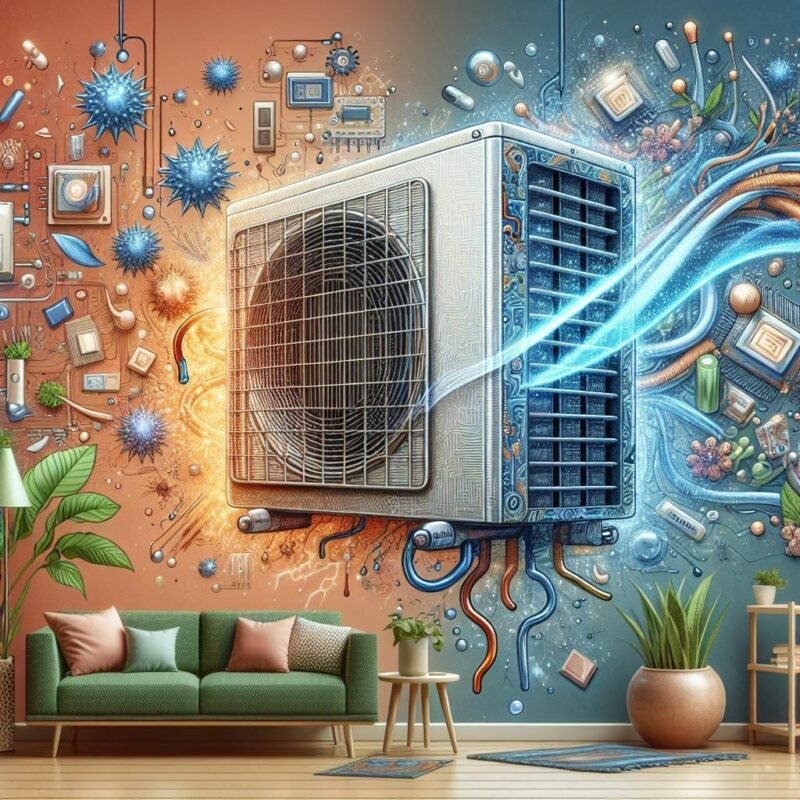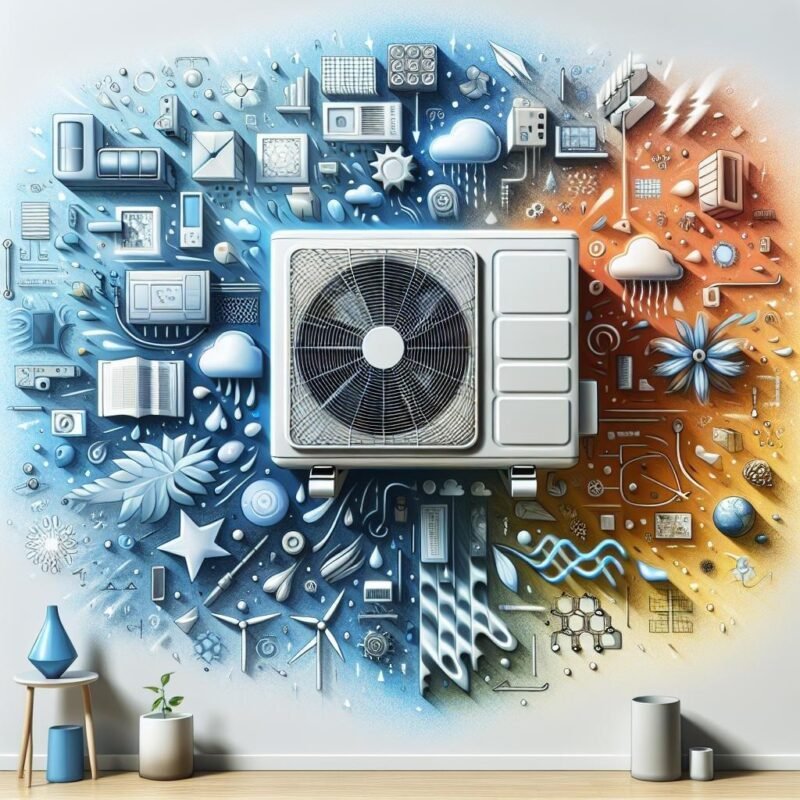A Comprehensive Comparison of Ducted vs Ductless Mini Split Systems

Picture this: a sweltering summer day or a bone-chilling winter night, and you’re faced with a decision that could transform your home’s comfort forever. as homeowners increasingly seek efficient climate control solutions, two contenders stand out in the ring: the customary ducted systems and their sleeker cousin, the ductless mini-split. Like choosing between a classic novel and its modern adaptation, each system brings its own charm and capabilities to the table.Whether you’re building your dream home or upgrading your existing space, understanding these two heavyweight champions of home comfort could be the key to your perfect temperature paradise.
Unlocking the Battle: How Ducted and Ductless Systems Transform Your Space
Picture this: your home as a battlefield where comfort and efficiency wage a constant war. in one corner, we have the mighty ducted systems, channeling conditioned air through an intricate network of passages like a well-organized army. in the other corner,the nimble ductless units,striking with precision where needed,delivering personalized comfort to individual zones. Both contenders bring unique advantages to this climate control showdown, transforming your living space into a haven of perfect temperatures.
The true magic happens when you understand how each system orchestrates its performance. Ducted systems excel at maintaining uniform temperatures throughout larger spaces, while their ductless counterparts shine in their ability to create customized comfort zones.Consider these game-changing features:
- Zone-specific temperature control
- Energy-efficient operation methods
- Installation versatility options
- Aesthetic impact on your space
| system Type | Space Impact | Control Style |
|---|---|---|
| Ducted | Hidden design | Central Control |
| ductless | Visible Units | Individual Control |
Energy Efficiency Face-Off: Breaking down Operating Costs and Installation Impact
when it comes to your wallet and the planet, the battle between ducted and ductless systems reveals striking differences. ductless mini-splits typically consume 25-30% less electricity, thanks to their zoned heating and cooling approach, eliminating the energy waste associated with treating unused spaces.Plus, the absence of ductwork means zero energy loss through leaky ducts, which can account for up to 30% of energy consumption in traditional systems. However, the initial investment for ductless units might cause some sticker shock, running 30% higher than conventional ducted installations.
let’s talk installation impact. While ducted systems require extensive ceiling or crawl space modifications and can take up to a week to install, ductless units only need a small hole in the wall and can be up and running in a day or two. Here’s where it gets interesting:
| System Type | Install Time | Home Disruption | Monthly Savings |
|---|---|---|---|
| Ductless Mini-Split | 1-2 days | Minimal | $30-50 |
| Ducted System | 3-7 days | Significant | Baseline |
- Space Requirements: Ducted systems need attic/basement space
- Maintenance Impact: Ductless requires simple filter cleaning
- Environmental Footprint: Ductless systems use eco-kind refrigerants
Comfort Zones and Climate Control: Finding Your Perfect Temperature Match
Ever wondered why your living room feels like a sauna while your bedroom’s reminiscent of the Arctic? The key to achieving that elusive “just right” temperature lies in understanding how different HVAC systems cater to your space. With zoned temperature control, you can finally bid farewell to those endless thermostat battles and create personalized comfort bubbles throughout your home. Both ducted and ductless systems offer unique approaches to maintaining your ideal climate, but their methods of delivering that perfect temperature vary significantly.
When it comes to climate control precision, consider these crucial factors:
- room-by-Room control: Ductless mini-splits excel at providing individualized temperature settings
- Consistent Airflow: Ducted systems typically offer more uniform air distribution
- Temperature Response Time: Mini-splits generally adjust faster to temperature changes
- Humidity Management: Both systems can help maintain optimal moisture levels
| Comfort Feature | Ducted | Ductless |
|---|---|---|
| Zone Control | Limited | Excellent |
| Temperature Stability | Good | Very Good |
| Draft Prevention | Moderate | High |
Smart Home integration and Modern Features: Which System Adapts Better to Your Lifestyle
In the digital age, your comfort management should be as sophisticated as your smartphone. While both ducted and ductless setups offer smart connectivity, mini-split systems shine with their intuitive zone-by-zone control through dedicated apps.Picture adjusting your bedroom’s temperature while still at the office or setting up personalized schedules for each family member’s preferred spaces – that’s the level of customization you get with modern ductless solutions.
Traditional ducted systems aren’t far behind in the tech race, though. Many now feature:
- Voice command compatibility with Alexa and Google Home
- Learning algorithms that adapt to your daily routines
- Energy usage reports and optimization suggestions
- Remote troubleshooting capabilities
| Feature | Ducted | Ductless |
|---|---|---|
| Zone Control | Basic | Advanced |
| Smart Integration | Good | Excellent |
| Setup Complexity | Complex | Simple |
Q&A
Q&A: A Complete Comparison of Ducted vs Ductless Mini split Systems
Q1: What exactly are ducted and ductless mini split systems?
A1: Grate question! Ducted mini split systems use a network of ducts to distribute conditioned air throughout your home,similar to traditional HVAC systems. On the other hand, ductless mini splits consist of individual units that are installed directly in the rooms where cooling or heating is needed, eliminating the need for ducts. Think of ducted as a well-connected community and ductless as cozy, inviting cottages scattered amongst the trees!
Q2: What are the main advantages of ducted mini split systems?
A2: Ducted systems really shine when it comes to aesthetics and air quality! Since they’re hidden behind walls or ceilings, you won’t have visible units cluttering your decor. Plus, they can effectively filter and circulate air throughout your entire home, promoting better indoor air quality. Perfect for those who love a unified look in their living spaces!
Q3: And what about the benefits of ductless mini split systems?
A3: Ah, the charm of ductless! These systems are incredibly flexible and allow you to zone your home, meaning you can set different temperatures for different rooms. They’re also easier to install, often requiring only a small hole in the wall for the connecting line. Plus, since there are no ducts, you won’t have to worry about dust build-up and energy loss through leaks. It’s like having a tailored outfit for every room!
Q4: Are there any downsides to either system?
A4: Absolutely, both systems come with their own quirks. Ducted systems can be more expensive to install due to the ductwork needed, and they may consume more energy if not properly maintained. Ductless systems, while versatile, may require multiple units for larger homes, which can increase costs and perhaps alter the aesthetics you’re aiming for.It’s all about finding the right fit—like a comfy pair of shoes!
Q5: How do energy efficiency and cost compare?
A5: Energy efficiency can vary widely based on model and installation, but ductless systems often have an edge here with inverter technology, which allows them to adjust their cooling power based on demand. In terms of upfront costs, ducted systems may initially be pricier due to installation, while ductless might have a lower price tag but could add up with more units for larger spaces. Think of it as an investment—you’ll want to weigh the long-term savings against initial spending!
Q6: How about maintenance? Which system is easier to maintain?
A6: Great thought! Ductless systems tend to require less maintenance as they don’t have ducts where dust and allergens can accumulate. Just some regular cleaning of the filters and occasional professional check-ups will keep them humming along nicely. ducted systems, however, need periodic duct cleaning and inspection to ensure everything is running smoothly. It’s a bit like keeping your garden tidy—some extra love goes a long way!
Q7: Which system would you recommend for specific scenarios?
A7: It depends on your unique situation! If you have a larger home with multiple rooms and want a seamless look, ducted might be your go-to. For smaller spaces, renovations, or rooms that are often used sporadically (like a guest room), ductless is a fantastic choice. Ultimately, it boils down to your lifestyle, budget, and personal preferences. Just like choosing a favorite ice cream flavor—there’s no wrong answer if it makes you happy!
Q8: Can I combine both systems?
A8: Absolutely! Many homeowners find the perfect balance by using both systems in different parts of their homes. For example, you could install ducted for the main living areas and ductless units in bedrooms or home offices. It’s a bit like mixing and matching your wardrobe—layering for style and comfort!
Feel free to reach out with any more questions! Whether you choose ducted or ductless, the ultimate goal is to find a system that keeps you comfortable in every season. Happy heating and cooling!
To Wrap it Up
As we wrap up our deep dive into the world of ducted and ductless mini-split systems, we hope you feel more empowered to make an informed choice for your home. Both systems have their unique charm and functionality, much like the personalities of the rooms they serve. Whether you lean towards the seamless elegance of ducted systems or the flexible, space-saving allure of ductless designs, the right solution is just waiting to be discovered.
Remember, your heating and cooling system is more than just a comfort feature—its an integral part of your home’s atmosphere and energy efficiency. Take the time to weigh your options, consider your space, and envision how each system fits into your life. With this knowledge in hand, you’re now equipped to create a cozy haven that matches your lifestyle perfectly.
And of course, if you have questions or need more personalized advice, don’t hesitate to reach out! Here’s to comfort, efficiency, and finding the perfect climate companions for your home sweet home. Stay cool (or cozy warm) out there!






















